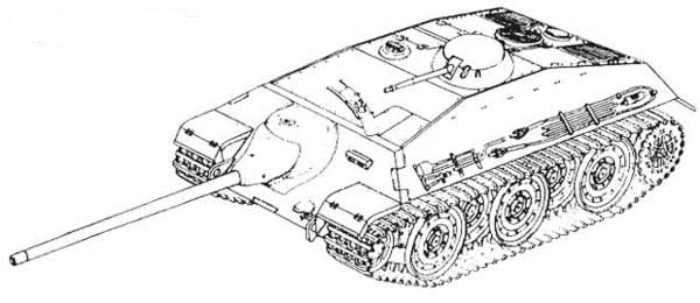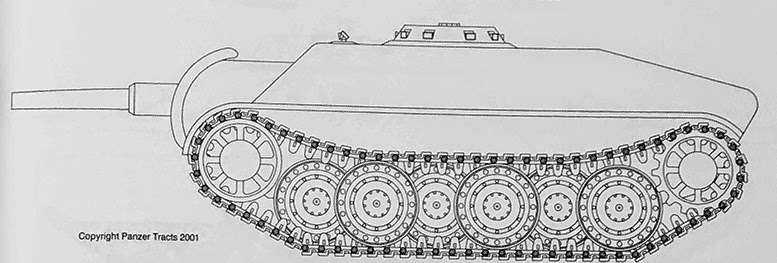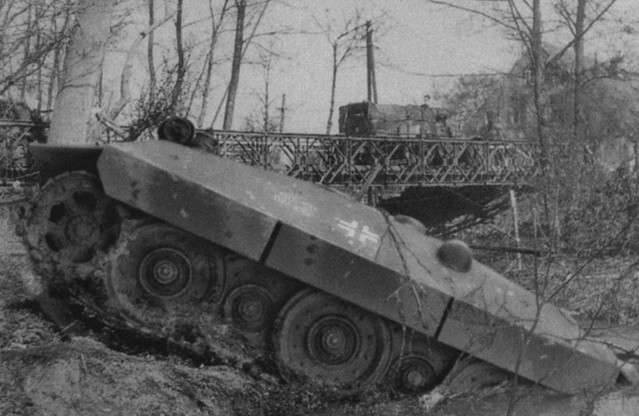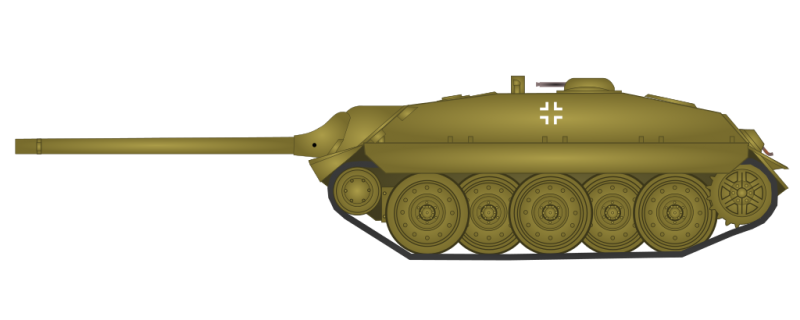The project of self-propelled artillery installation Adlerwerke E-25 (Germany)
The prerequisites for the emergence of the E-25 project appeared by the middle of the 1942 year. By this time, the command of the German armed forces came to the conclusion that it was necessary to reduce the range of armored vehicles. On arms at the same time consisted of a large number of different models, which to some extent hampered their parallel operation and maintenance. Based on the results of studying the current situation in the troops and the situation at the front, an original concept of the further development of armored vehicles was created.
A group of specialists led by Heinrich Ernst Knipkamp developed the concept for the further development of military equipment, which involved the creation of machines with certain functions. Based on the existing combat experience, several types of equipment were formed with various functions on the battlefield. It was assumed that the emergence of new technology, originally calculated under the conditions of the theater of military operations, will significantly increase the combat capability of the troops. The result of the new concept was the appearance of a list of requirements for six types of promising armored vehicles. AT stories this family remained under the symbol "E-series" (Entwicklung - "development" or "development").

General view of ACS E-25. Figure Warspot.ru
Among other equipment in the program "E" proposed the creation of medium tank with a combat weight of 25-30 tons and a 75 mm gun. It was planned that in the medium term such a tank would be able to replace the Pz.Kpfw.III and Pz.Kpfw.IV tanks, as well as self-propelled guns based on them and some other equipment. By the name of the series and the lower border of the combat mass, the new project received the symbol E-25. It should be noted right away that this name designated two projects created by different design bureaus. This should be considered to avoid confusion.
An important feature of the program "E" was the approach to the choice of developer companies. The command did not want to burden the additional work of design bureaus, which were already engaged in new projects. As a result, the Adlerwerke company, which was engaged only in the production of various types of equipment, received an order for the development of the E-25 tank. An order for a new project was issued in the middle of 1943. The main designer of the new project was Hermann Klyau.
The project requirements were given a very high level of protection, but the weight of the machine should not exceed 30 t. Such requirements forced Adlerwerke designers to reconsider their views on the design of the prospective machine. The experience of hostilities showed that the SAG StuG III and other similar equipment, thanks to its low silhouette, are distinguished by a high survivability on the battlefield. At the same time, they are quite light and not inferior to tanks in mobility. Thus, in the course of the new project E-25, it was decided to build not a “classic” tank with a swiveling turret, but a self-propelled artillery unit with a gun in the front hull plate. Only such an architecture of the machine made it possible to fulfill all the existing requirements without any special loss in certain characteristics.
Perspective armored vehicle received a new body, the design of which was based on some existing developments. A new design with large angles of inclination of the sheets was proposed, allowing to increase the level of protection for the crew and internal units. A sloping front sheet with a window for an instrument was proposed, from behind and above it should have been in contact with the roof sheets. To preserve acceptable internal volumes and provide the required protection, the roof was proposed to be made of three sheets: horizontal central and inclined front and rear. The sides of the machine should be installed with a slope inward, which allowed the use of internal volumes of the fencing shelves to accommodate various equipment and ammunition layouts. On the frontal part of the body, it was planned to install cast units of the mask of an instrument of complex shape.
The welded body should consist of sheets of different thickness. The top frontal sheet had a thickness of 60 mm and had to be installed at an angle 45 ° to the vertical. The lower frontal part was half thinner. The roof of the hull and the feed should have been made of 20-mm sheets, and the installation angle of the feed part was equal to the angle of the upper front sheet. The side protection was placed on 30-mm sheets. It was assumed that the booking of sheets of medium thickness with rational angles of inclination would provide protection against a number of threats from enemy tanks and artillery. Additional means of protection should have been stealth, due to the small height of the hull, and mobility achieved with the help of a powerful engine.
The internal volume of the body of the E-25 was proposed to be used in the same way as in the case of other self-propelled guns of that time. In front of the hull, there was a manned volume accommodating the workplaces of the entire crew and the breech of the gun. Feed was given under the engine. It is noteworthy that in the new project it was decided to abandon the traditional separation of the engine and transmission in different parts of the hull. Instead, it was proposed to shorten the length of the machine by transversely mounting the engine, which made it possible to place the transmission units in the aft compartment of the hull and connect them to the rear wheels.
When searching for a suitable power plant, Adlerwerke engineers had to face certain difficulties. Initially it was assumed that the machine will receive a promising water-cooled engine manufactured by Maybach 400 hp. For various reasons, this motor was not put into a series, which is why the authors of the E-25 project had to choose a new one. Soon there was a proposal to use 350-strong aircraft engine air cooling. However, such a motor could greatly complicate the design of the machine, since it had special requirements for the engine compartment, its ventilation, etc.
As a result, it was decided to equip the new ACS with an engine of the existing model, which is already in serial production. On the stern of the E-25, the Maybach HL 230 P30 carburetor, hp 700 hp, which was already used on several serial armored vehicles, should have been installed. It is noteworthy that when applying the planned engine power 400 hp the power density of self-propelled guns would not exceed 16 hp per ton (with a combat weight at the minimum level of 25 t). The HL 230 P30 engine, in turn, could bring this parameter to the HP 25-28. per ton. Due to this, the maximum speed could reach 60-65 km / h, which was not superfluous in view of the specific views on the protection of the machine.
Adlerwerke engineers developed a new undercarriage based on existing groundwork. On each side of the hull it was proposed to mount five large-diameter road wheels that partially overlapped each other (the so-called Knipkamp suspension). The rollers should be mounted on an individual suspension, apparently based on torsion bars. In front of the hull there were guide wheels, in the stern - leading wheels.

Self-propelled version with howitzer armament. Figure Wot-news.com
The original terms of reference required to equip the machine E-25 75-mm tank gun KwK 43. However, the protection of enemy tanks was improved, which led to a reduction in the potential of this weapon. At a certain stage, it was decided to install the 7.5 cm KwK 44 gun, developed by Krupp and Škoda, on a new ACS. Such an instrument was distinguished by increased characteristics of fire, and also in the future could receive automatic loading. The latter, according to calculations, allowed to do up to 30-40 shots per minute. However, the development of a new gun was delayed, which is why the authors of the self-propelled gun project had to look for alternative options.
According to some information, the possibility of using not only tank guns, but also other systems was considered at the re-selection stage. In particular, the E-25 could become a carrier of a howitzer with corresponding consequences for the method of application of such equipment. The possibility of using an 8.8 cm PaK 43 88 anti-tank gun, which could make a self-propelled gun one of the most powerful tank destroyers, was also tested. Some sources mention that the E-25 with the PaK 43 cannon was designated Panzerjagerwagen and had the additional name Jaguar. It should be noted that the name “Jaguar” is sometimes applied to the entire E-25 project.
For self-defense from infantry or light equipment of the enemy, the E-25 ACS should have received a small turret with additional weapons. On the roof of the hull, with a shift to the stern, it was planned to install a low-height turret with a rifle-caliber machine gun or an 20-mm automatic cannon. With the help of such weapons it was possible to fire at targets that would be inappropriate to destroy the main armament.
The crew of self-propelled guns of the new type was to consist of four people: the driver, the commander, gunner and loader. The driver's seat was located in the front of the case, to the left of the gun. To monitor the road in the front sheet provided viewing devices. The gunner was placed to the right of the gun, which had the guns with aiming drives and a sight. Behind the driver was the place of the commander, and the loader had to be in the rear right part of the habitable volume. To get inside the car was proposed to use a set of hatches in the roof.
By the middle of 1944, Adlerwerke's specialists completed the development of the project for the self-propelled artillery E-25. In the second half of 1944, the command familiarized with the project and gave the go-ahead for the construction of the first self-propelled gun prototypes that were to participate in the trials. The production of experimental machines was entrusted to several enterprises. Thus, the manufacture of armored hulls was assigned to a metallurgical plant in Kattovice (now Katowice, Poland), and the final assembly was to be carried out at one of the enterprises in Frankfurt am Main.

Photomontage, allegedly confirming the participation of E-25 in the battles. Photo Warspot.ru
The manufacture of several armored hulls for E-25 took considerable time, since the plant had to produce other products in the interests of the serial construction of armored vehicles. By the end of January, 1945, several armored units were assembled in Kattowice, which were soon planned to be sent for assembly. However, the collector has not received the required items. 27 January 1945, the Red Army liberated Katowice and seized the plant, along with the corps for serial and experienced armored vehicles.
This is where the story of the E-25 project from Adelwerke actually ended. The war came to an end, and Nazi Germany no longer had the opportunity to reassemble the required corps, build self-propelled self-propelled guns on their basis, test and deploy mass production. In addition, by this time there should have been problems with promising weapons for self-propelled guns. Until the end of the war, German industry failed to complete the development of the 7.5 cm KwK 44 cannon, due to which the E-25 project had to face additional problems and the need to redesign the weapons system.
The further fate of several built hulls for ACS E-25 is unknown. Probably, soon after the discovery they were sent to the smelter as useless. Nevertheless, there is no confirmed legend that at least one new self-propelled gun was built and even participated in the battles. In confirmation of this version, there is a single photograph, which, however, upon closer inspection, is the result of a photomontage. Thus, the history of the E-25 project ended at the end of January 1945, when the German industry lost the hulls for new cars, and with them the hope of building them.
It should be noted that the project of ACS E-25 from the company Adlerwerke can be considered quite successful in terms of implementation and execution of the planned work. Of the six projects of the E-series, only E-25 and E-100 reached the prototype construction stage. However, the construction of both cars was not completed, and the assembled units became trophies of the allies. In addition, the project E-25, created under the direction of G. Klyau, has progressed much further than the alternative development from Porsche, which had the exact same name. The Porsche E-25 project was not even able to exit the design stage.
Based on:
http://achtungpanzer.com/
http://warspot.ru/
https://warthunder.ru/
http://wot-news.com/
Chamberlain P., Doyle H. Complete reference book of German tanks and self-propelled guns of the Second World War. - M .: AST: Astrel, 2008.

Information